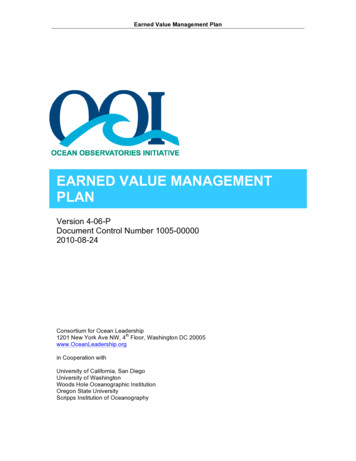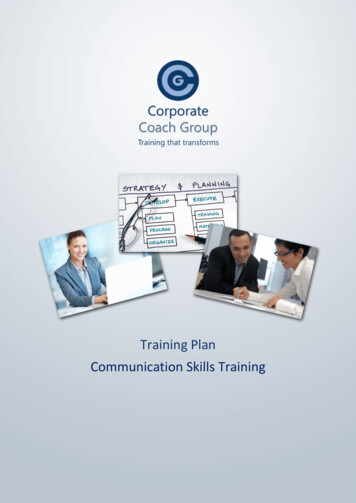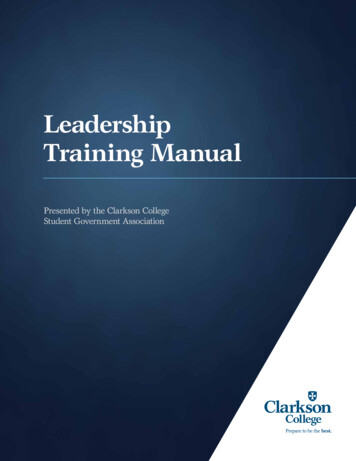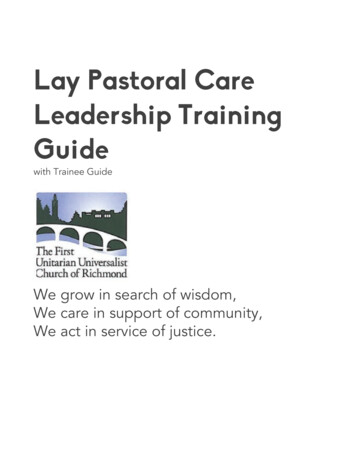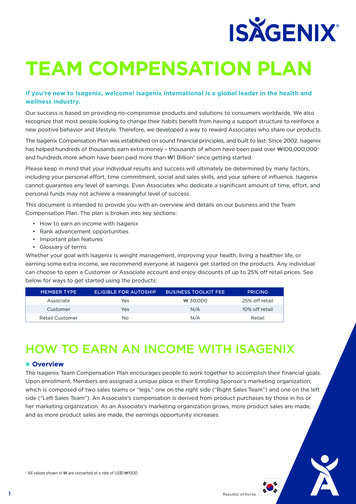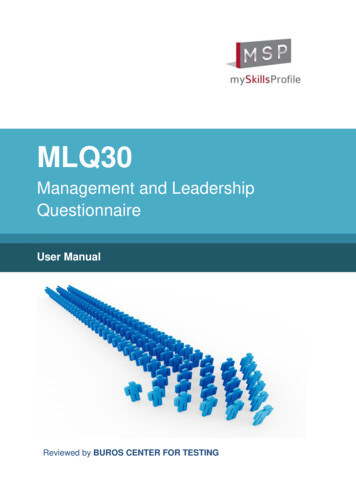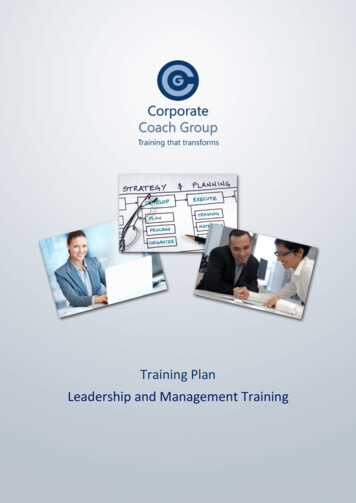
Transcription
Training PlanLeadership and Management Training
Training PlanLeadership and Management TrainingWhat is the purpose of the training?The purpose of the training is to initiate a process of rapid improvement, by means ofachieving a shared understanding of the correct knowledge and skills that we need toemploy, if we are to achieve our stated goals.Leadership and Management Course SummaryOn this leadership and management training course, you will learn the leadership skillsyou need, goal setting, effective communication, motivation, time management andmuch more. This short course will give you all the skills you need to be more effective,without having to enrol in a business school to study for a technical managementqualification. Attend this two-day leadership course, where you will learn the mostmodern and effective leadership management skills. This excellent two-day course willgive you a proven, step-by step guide to success.Learning Outcomes for the Leadership and Management Course A State-of-the-art Team Leadership and Management training courseLeadership skills that will inspire others to give you their best performanceCommunicate your message with greater clarity and confidenceTime management skills training. Prioritisation, preparation and delegationHandle difficult people, resolve conflicts, more quickly and with less fussInspire yourself - more self-confidence and motivationDevelop an inspirational leadership style - more motivation, optimism and confidenceCustomer Review“I found the Wrong Box / Right Box tool and the delegation part of the course reallyinteresting. It’s given me a great base for my new managers role. Chris (the trainer) isamazing. He is really enthusiastic and engaging and I have enjoyed his training. ThanksChris!!Rebecca HuntDiagnostic Healthcare LtdPage 2
Training PlanLeadership and Management TrainingLeadership and Management Training Course OverviewThe objective of this course is to teach the essential knowledge people need to become asuper-effective leader manager. This Leadership and Management Training Course is aboutdeveloping a set of specific attitudes, behaviours and skills which, when applied, allow you toperform perfectly.To get the best performance from yourself and others, we develop six major skills sets ofleadership management:1.2.3.4.5.6.Set and achieve specific goalsCommunicate with clarity, confidence and persuasivenessProperly plan, prioritise and delegate your workPerformance management, conflict managementMotivate and inspire yourself, so that you always feel strong and confidentMotivate and inspire other people and create a productive work atmosphere1. A sense of clear purposeThe ability to create a clear and distinct goal and commit to it long enough for it to beattained. As opposed to, when difficulties and setbacks appear, dropping the first goal andstarting a new goal, then later dropping that one, to start another goal.2. Excellent communication skills: accurate languageThe ability to accurately explain your ideas to others, in such a way that they will understandyou, agree with you and will act in accordance with your ideas. As opposed to suffering anexcessive number of miscommunications, misunderstandings and avoidable upsets.3. Rational, logical planning skillsThe ability to analyse the facts and formulate detailed, written plans of action that willachieve the goal in the most efficient manner possible. As opposed to being constantlyuncertain and always feeling that you are reacting to events or reacting to the current crisis.4. Rational conflictThe ability to guide and harmonise the various personalities in the team, so that they aremore able to synchronise their actions and be more likely to reinforce and complement eachother. As opposed to a disharmonious atmosphere with office character clashes, internalsquabbles and people conspiring against each other. In addition, the ability to handle difficultconversations and performance issues.Page 3
Training PlanLeadership and Management Training5. Inspire and motivate yourself (personal management)The ability to maintain a positive mental state of optimism and realistic self-confidence,especially during the tough times. As opposed to, losing heart after a defeat, or series ofsetbacks, or criticisms.6. Inspire and motivate other people (leadership qualities)The ability to inspire the positive emotions of self-belief, desire and self-confidence in all theother members of the team, especially during difficult times. As opposed to allowingexcessive negativity, pessimism or fear to take hold of the team and weaken its spirit.A team leader-manager is one who has these abilities developed to a high degree.Customer Review“This was an excellent course. Real life-changing, approach-changing tools provided.Definitely a must for any managers/leaders who want to achieve great results. Thetrainer’s presentation was also excellent.Imran AliAshmans SolicitorsPage 4
Training PlanLeadership and Management TrainingLeadership and Management Training Course DetailsSession 1 What is leadership and management?The purpose of leadership and management is to inspire the best performance from others, inorder to achieve your goals and objectives.To get the best from others, you must first get the best from yourself.Leadership and management training is primarily about developing your personal skills, sothat you can inspire others to give you their best.Develop your leadership management styleThe most important thing is to have a clear vision for the future, and a clear goal focus.If we agree that success means, “the achievement of your goals”, then goal focus is the mostimportant quality of the successful leader manager.How to set goals, using the eight-part SMART goal-setting formulaMost people know the SMART target model, but most don’t use it because it is too abstract.We need to make SMART more usable. Eight-part SMART makes goal-setting a learnable setof eight questions.Page 5
Training PlanLeadership and Management TrainingExercise: Develop your skills by doing a real life, practical, goal setting example.Asking the right questionsLeaders do not only issue orders, they also develop the habit of gathering specific informationby asking the right questions. We can use the SMART model as a formula for asking the rightquestions.Leadership Styles: Decide how you want to be perceivedEvery day, you leave impressions in the minds of others. What impression do you want toleave in their mind? How do you want others in your organisation to perceive you? Whatqualities do you want to be known for? Do you want to be motivating and inspiring and havea great leadership style?Exercise: Develop your skills by doing a practical example of “Impression management”.The proper use of humourHumour is a double-edged sword. Humour can work both for you and against you.How can humour work to add value to yourself and the rest of the team?Have you seen the misuse of humour cause problems (particularly in a team leadershipsituation)?What is the correct use of humour?What is the misuse of humour?Exercise: Develop your leadership skills by doing practical examples.Page 6
Training PlanLeadership and Management TrainingSession 2 How to communicate with greater clarityLeader-managers must NOT give any ambiguous or vague instructions. They should have aclear, rational leadership style.Leader-managers must know how to communicate their message with clarity and accuracy.There must be no misunderstanding of the meaning of the message.How to create definitions of all your key terms, using the C.G.4.D method.Exercise: Develop your communication skills by doing practical examples.Affirmative or negative language Affirmative language is talking about what you CAN and WILL doNegative language is talking about what you CANNOT or WON'T doNon-leaders spend too much time talking about what they won’t doLeaders spend most their time talking about what they will doExercise: Develop your skills in transforming the conversation from the negative to theaffirmativeLearn the Language of a Leader.Positive v negative suggestionsWe influence each other by the way we speak. Unfortunately, we sometimes accidentally givenegative suggestions in the form of negative commands. For example: DON’T PANIC! is asuggestion to PANIC.Stop giving negative suggestions and be much more conscious of the way you word yourmessage, suggesting only positive images to the mind. Talk about what you want, not whatyou don’t want.Ensure that the last thing you say to them is WHAT YOU DO WANT.Exercise: Develop your leadership communication skills by practical examples.Page 7
Training PlanLeadership and Management TrainingSession three: Performance management. Handling conflict situations.Handle conflict reasonably NOT emotionallyWhen in performance management and conflict situations, many people get too emotional.How can you limit the damage that negative emotions can have on the conversation?Don’t emotionalise the conflict; instead rationalise it.We will show you how.Self-image psychologyThe self-image is the way a person views him/herself.It is the basis of their character.Never attack a person’s self-image.Never attack a person’s character (identity).Comment only on their behaviour, not their identity.We will show you the difference between identity statements and behavioural statements.Page 8
Training PlanLeadership and Management TrainingObjective v subjective languageSplit language into two sets, objective fact-based language and subjective opinionatedlanguage.When in conflict, use only objective fact-based language.Do not use subjective opinionated language.We will discuss examples and you will learn how to get rid of the dangerous subjectivelanguage.How to script conflict situationsWe will take real life situations and script them.Then we will run them as (optional) role plays.You can practice if you want to, or if you don’t like role plays, you can learn by observingothers.It is important you put into practice what you learn.Distinguish reasons from excusesThere are big differences between “a reason” and “an excuse” for not doing something.We will discuss what those differences are.We give concessions only to reason-givers.We don’t give concessions to excuse-givers.We will discuss what happens if you give unearned concessions to excuse givers.Don’t spend much time arguing about the pastMany people spend too much time arguing over what has already happened.We will discuss why this may be a waste of time.We will show you how to get the conversation back to the future.Page 9
Training PlanLeadership and Management TrainingKnow when to compromise and when not tooOften life is about finding a compromise solution that everyone can live with. BUT at othertimes, compromise is the worst thing you could do.If you compromise on safety or if you compromise your integrity, then you could loseeverything. We will discuss, when is it right to compromise and when you should not.Proper use of body language and voice tonesIt is not only what you say that counts, but also HOW you say it.We will discuss the proper use of voice volume, tone and pace.We will discuss body language, eye contact, facial expression, hand gestures, and posture.Assertive, but not aggressiveWe will put words, voice tones and body language together, to form a communication stylethat is polite, assertive, professional and effective. Never passiveNever aggressiveWe will practice these skills.Social motivatorsWe have spent a lot of time talking about how to give constructive criticism. Now we will talkabout the social motivators of praise, appreciation and thanks.We will look at why many managers forget or neglect to give proper praise and appreciationand how that omission costs them.We will examine how and when to give praise appreciation and thanks.Summary and Action PlanningWe discuss the topics covered on Day 1, examine which were the most important for you,together with where and how you can apply them in your workplace.Page 10
Training PlanLeadership and Management TrainingSession 4 How to manage your time as a leader?Time management is the art of doing the most valuable things, in the most efficient order.Time managers do not do the easiest, or most pleasant things first, they do the most valuabletasks first.What is the most valuable use of your time, right now?Use the two principles of "deadline pressure" and "value" as key indicators.1.2.3.4.Q1 Crisis: High value, late workQ2 Productive: High value: preparation, prevention and planningQ3 Busy: Low value busy-workQ4 Fruitless: Waste of time activities, gossipDistinguish between being 'Busy' and being 'Productive'The danger is you become so busy, that you are no longer productive. Our enemy is the busy,but non-productive days.Page 11
Training PlanLeadership and Management TrainingTime wasters SOS - Self, Others, Systems1. Self: Your own bad habits steal your time2. Others: Other people who steal your time3. Systems: Inefficient work systemsTime Management ExerciseWhat can you do to minimise the damage done by SOS?Time management questionnaireQuestions designed to tease-out exactly how you could improve your time management skills.DelegationDefinition: Delegation is the act of entrusting a task to another.Delegate the right task, to the right person, in the right way.Exercise: What are the right reasons to delegate? What are the wrong reasons to delegate?Effective DelegationHow to delegate tasks. Use the same formula we used to set goals.Review of goal-setting notes. 8 Part SMART.Why people are afraid to delegateFour reasons why people who should delegate, sometimes don’t.Effective PrioritisationDefinition: The art of putting tasks in the right order.Prioritise your tasks by means of a decision matrix.Page 12
Training PlanLeadership and Management TrainingFive Types of decision matrix1.2.3.4.5.Priority decision matrix 1: Prioritise by valuePriority decision matrix 2: Prioritise by logical sequenceYes or No decision: Should I or Should I not?If yes, then which one, what kind?One problem – three causes – six solutions mappingWhat are the advantages of using a structured approach to decision making?Managing InterruptionsYou are continually peppered by interruptions, which you need to effectively manage.Strive to make the maximum progress, in the minimum time, without causing offence toanyone.Managing Interruptions by means of the 80/20 PrincipleThe 80/20 principle (the Pareto Principle) states that 80% of the value comes from 20% of thecontent. 80% of the value of the interruption will be in 20% or less of what they say. Your taskis to quickly discover the 20% of their message which contains 100% of the value.You need to work out a formula of words that works for you.How to use the Pareto 80-20 rule in conversationsHow are you going to get the maximum benefit from any interruption, in the minimumamount of time, without causing offence?How can I improve my management of emails?Emails can be a distraction. How to minimise the problem - we will discuss how you can getthe best from emails.Page 13
Training PlanLeadership and Management TrainingSession 5 Emotional Management in a Leadership RolePeople are affected strongly by how they feel.In order to get the best from people you must know how to manage emotions.We will show you how to master your own emotions first, and then how to manage otherpeople’s emotions.You cannot positively affect others until you can positively affect yourself.So, we start with how you can affect your own mental and emotional states.Some people call this skill mindfulness.Manage how you feel, then you can improve your productivitySelf-fulfilling prophecyThe self-fulfilling prophecy shows how your thoughts, beliefs, actions and results relate toeach other.Whatever you believe will affect your results, because you are empowered or dis-empoweredby your belief systems.We will discuss the ways in which what you believe affects your personal reality.And we will show you how you can change your personal reality.How to create and sustain a positive mental attitudeNegative attitudes tend to create negative results.Positive attitudes tend to create positive results.We will show you exactly how to put limits on fear and anger, (negative emotions)We will show you how to harness the power positive thinking and language.Page 14
Training PlanLeadership and Management TrainingHow to inspire others to feel stronger and more optimisticEverything you say will either:1. Make people feel better, or2. Leave them unchanged, or3. Make them feel worseYou don’t want to leave them unchanged. You don’t want to leave them feeling worse.Everything you say should be geared to making people feel better.We show you how.How to transform negative conversations into something more valuableThere are many people who don’t know that they are having a negative effect on others.We will show you how to transform their negative conversations, into something far morepositive.We call this “conversation control”.It is a skill you must master.How to handle physical and mental stressYour feelings are also affected by your physical stress levels.We will discuss how stress can be a positive and negative factor in your life.We will minimise and manage the negative effects of stress.Page 15
Training PlanLeadership and Management TrainingSession 6 Continuous improvement.The success formulaSuccess is not an event. It is a process.It contains five major steps.Purpose, plan, action, feedback, CHANGE.We will discuss how people react to change.How to transform failure into feedbackEveryone has to deal with disappointments andsetbacks. Your job is to help them to recover quicklyand to return tomorrow feeling stronger and to beready with a new plan. We will show you how to build emotional resilience into the fabric ofthe team.How to use your language to make others more confident, optimistic and effectiveYour life revolves around your use of language.If you talk to people in ways that are inspiring, supportive, optimistic and motivational, thenyou are much more likely to succeed.We will discuss which kinds of words help to inspire.Inspire others by the art of conversation controlWe will discuss how you can control the conversation that you hear at work.How to improve the atmosphere and team culture.Review of whole course.Final summary and closeHow you can put these ideas to work.Page 16
Training PlanLeadership and Management TrainingCustomer Review“The course content was great, very in-depth and made simple to understand. Trainerwas very helpful and clear on his presentations, very informative.Vicky HayesDomino’s PizzaPage 17
Training PlanLeadership and Management TrainingTraining Costs / InvestmentBespoke In-House or Live-Online Course 1,950 VAT per training dayPlus, hotel accommodation for trainer if needed (Premier Inn type: not the Hilton!)(International Price Varies)In-House training has been designed to provide a similar experience to our open courses,however we can tailor the content to fit your specific needs.We are able to train in your timezone.All our training includes: Two full days of quality training, delivered by an experienced trainerCPD - endorsed training course: Total of 12 CPD training hours (usually 9am - 4.30pm),plus an additional 2-3 via post-course online independent learningFull digital interactive course notesTraining certificateAccess to additional free training material after the course via our post-course portal3 months free telephone coaching: Whilst you are implementing what you havelearned, if you need to, you can contact us for support and guidanceWe suggest the following plan of action:Please send to us:1. Any amendments or changes you wish to make to the programme.2. Your thoughts.3. The next step you would like us to take.Thank you.Corporate Coach Training LtdWalcot HouseParton RoadChurchdownGloucestershireGL3 2JJEmail: lindsey@corporatecoachgroup.comTel: 44 (0) 1452 856091Page 18
Training PlanLeadership and Management TrainingCustomer Reviews“Great variety of topics and modules covered. Manuals very helpful and easy tofollow. Trainer presentation was very good.“Very constructive and thorough. Broke down many aspects of human and officeculture. This training course makes you think and approach situationsdifferently. The presentation was very clear and helpful. Great use of personalexamples and experiences to help relate to topics in the course. Breaks downeach topic very well and a good listener as sell as giving back advice.Danielle DuttonShaws (Huddersfield) LtdMichael DowlingMackevision“Hugely valuable, I have gained insights and tools to equip myself to hopefullyaid in becoming a better leader. I feel I need to read more course content soonto imbed my understanding. Trainer presentation was brilliant! Kept us going.Hugely knowledgeable and entertaining. Fantastic presentation. Inspirational!Carrie LomaxBristol Centre for Reproductive Medicine“The course content was very informative and related to many of the problemsassociated with leading a team of people. This has helped me reflect on mypractice and identify how I can develop further. The trainer’s presentation wasvery lively and kept me focused on the topics being discussed. A whole day oftraining - on a Saturday - I didn’t even get bored.Stefanie RigbySittingbourne community collegePage 19
Training PlanLeadership and Management TrainingWelp magazine have identified corporate coach training as a top provider because theironline virtual training is Practical, relevant, informative, interesting and fun.Practical.Corporate coach group training is practical because it focuses on the six most important skillsthat people need to put into practice every day: How to,1.2.3.4.5.6.Achieve goals,Communicate clearly,Manage time and prioritise tasks,Resolve conflicts,Self-motivate and create self confidenceInspire others.Relevant.CCG training is relevant because they show how to apply the knowledge in practical situationsthat you encounter every day, both at work and at home. They help people turn good theoryinto good practice.Informative.CCG training is informative because it is incredibly detailed and specific. They provide youwith full step by step guides on exactly what to do and say, (and what not to) in order to getthe best result from every situation.Interesting.CCG courses are interesting because their presentations are interactive, with a terrific balanceof presentation, demonstration, conversation and practical exercises, which keep everyonefully engaged for the entire duration of the training. People are amazed how the course keepstheir attention and how quickly the time seems to pass.Fun.CCG courses are fun, because they know people want their training to be entertaining as wellas informative and useful. CCG trainers have perfected the art of being fully focused andprofessional but with a sense of humour and fun. Everyone comments, not only on the CCGcontent but on their great training style.These are the reasons Corporate coach group were chosen and why people love theirtraining.If you want to know more, please follow this link.Page 20
Training Plan Leadership and Management Training Page 2 What is the purpose of the training? The purpose of the training is to initiate a process of rapid improvement, by means of achieving a shared understanding of the correct knowledge and skills that




